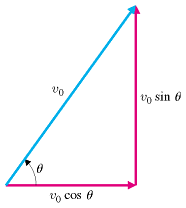A hose lying on the ground shoots a stream of water upward at an angle of 40° to the horizontal. The speed of the water is 20 m/s as it leaves the hose. How high up will it strike a wall which is 8 m away?
1 Answer
Explanation:
OK I'm going to be upfront here and say that I read the question as "horse" for an embarrassingly long time. Needless to say I was very confused.
For this question I'm going to explain what is happening from the basics up. Since you may already know some of this feel free to skim past the parts you are familiar with.
First we need to get the horizontal and vertical components of the water's velocity. We do this using trigonometry, imagining that the velocity is the hypotenuse of a right-angled triangle and the horizontal and vertical components are the horizontal and vertical sides.

The next task is to find the time it takes for the water to reach the wall. To do this we can use the horizontal velocity and the distance to the wall.
Now, we can use the equation
Where:
The water hits the wall

